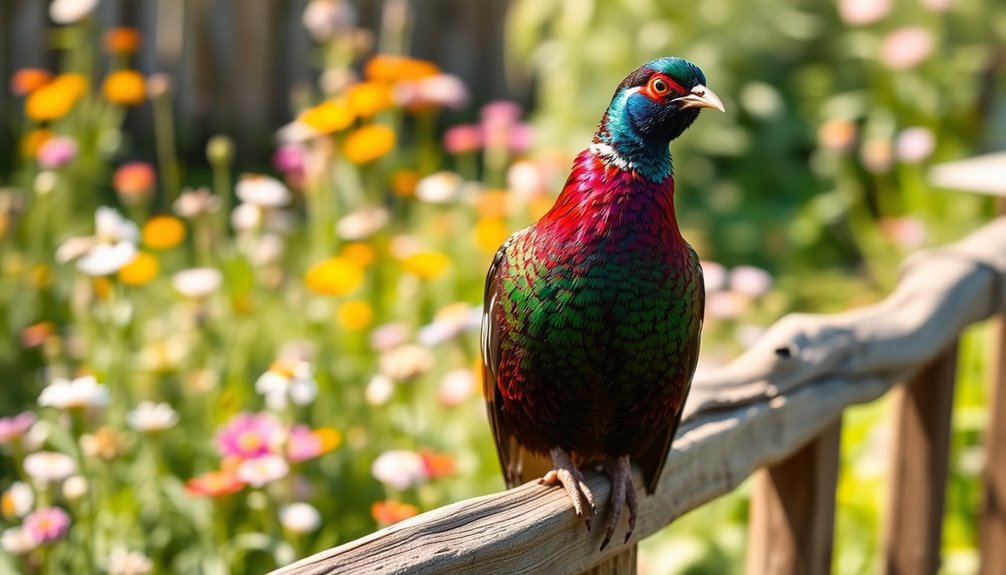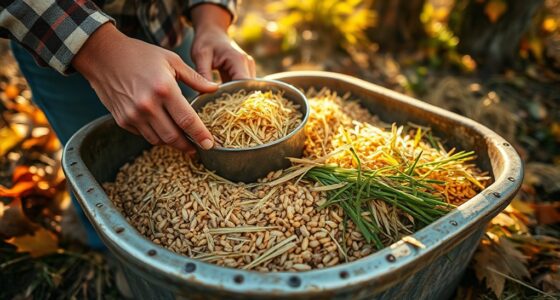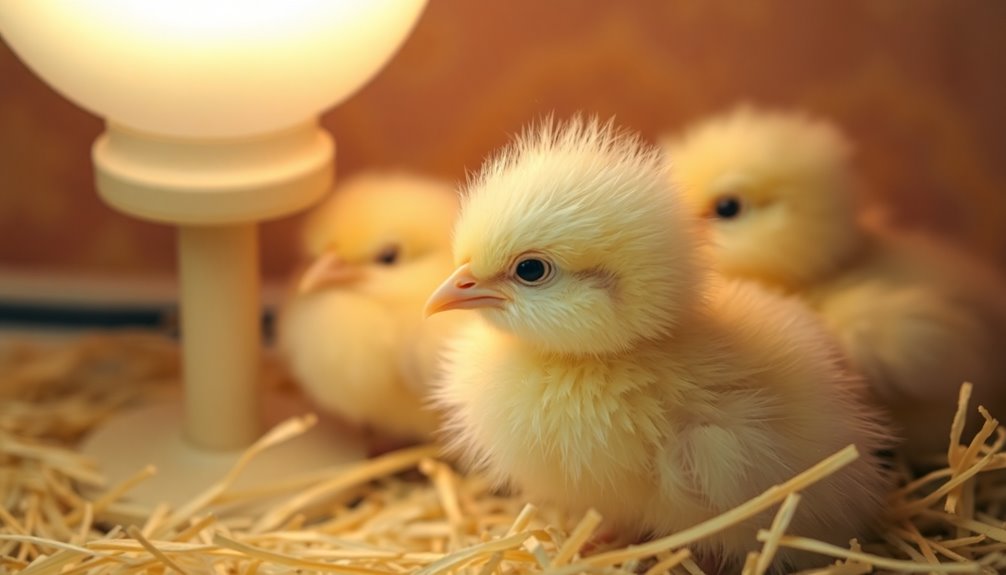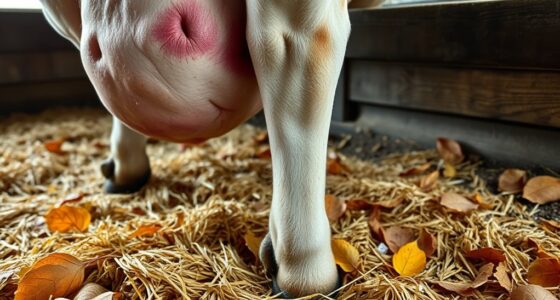Bringing a pet pheasant home means understanding their unique characteristics and needs. Pheasants are naturally shy and require patience to build trust. A spacious aviary of at least 6 x 12 feet is vital for their well-being. High-quality game pellets should form the basis of their diet, supplemented with treats like mealworms and fresh greens. Choosing the right species is important; silver and red golden pheasants tend to be friendlier. Regular care, predator management, and environmental enrichment will keep your pheasant happy and healthy. There's a lot more to discover about their care and companionship, so stick around!
Key Takeaways
- Pheasants require a spacious aviary (minimum 6 x 12 feet) with natural flooring and predator protection for their well-being.
- Their diet should primarily consist of high-quality game pellets, supplemented with insects, greens, and occasional treats.
- Building trust takes time; patience and consistent care, including treats, can help tame shy species like silver pheasants.
- Regular habitat cleaning and monitoring for health issues are essential for preventing diseases among pet pheasants.
- Awareness of local wildlife threats is crucial; implement secure fencing and predator deterrents to protect your pheasant.
Pheasant Characteristics
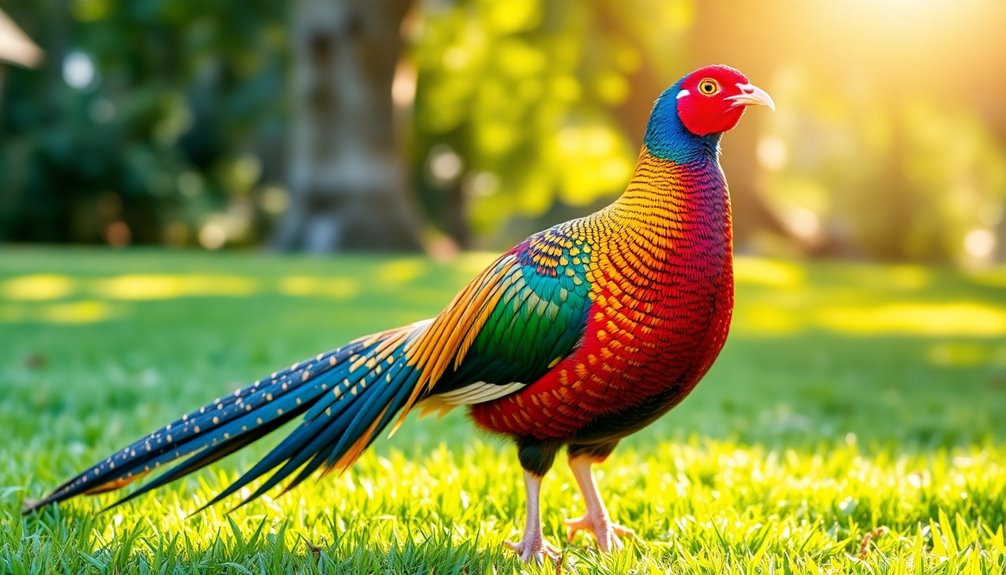
When it comes to pheasants, their beauty is truly enchanting. With striking colors and intricate feather patterns, these birds make stunning additions to your garden.
While keeping pheasants, remember they're naturally shy and may avoid you at first. However, with patience, they can become somewhat tame. Their instinct to fly means you'll need secure housing to protect them from predators.
Observing them foraging or dust bathing can offer a calming experience, enriching your garden environment.
Though pheasant eggs are edible, they're only laid seasonally, so don't rely on them for regular consumption. By understanding their characteristics, you'll create a harmonious space for these enchanting creatures to thrive.
Pheasant Behavior
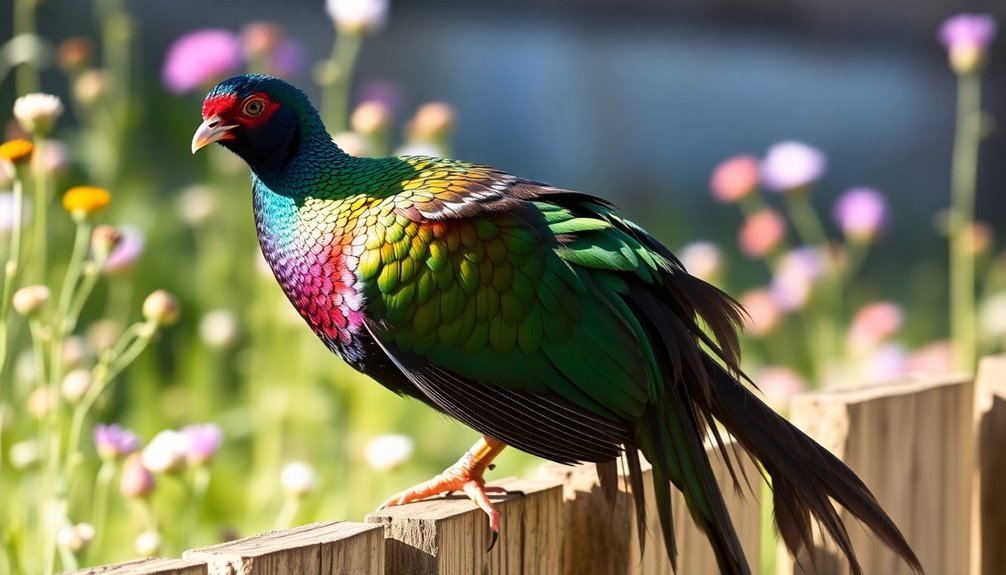
Pheasant behavior is fascinating and often reflects their natural instincts. Silver pheasants, like other types, are naturally shy and tend to avoid human interaction, making them skittish in unfamiliar environments.
With patience and consistent care, you might find that some pheasants can become somewhat tame, recognizing you as their caretaker. However, keep in mind that most pheasants dislike being picked up and may react defensively, which makes them less suitable as traditional pets.
To build trust, offer treats like mealworms and sit quietly nearby. Observing them foraging or dust bathing can be enjoyable.
If you're concerned about their flight, you might want to clip their wings to prevent escape while they adjust to their new home.
Housing Requirements
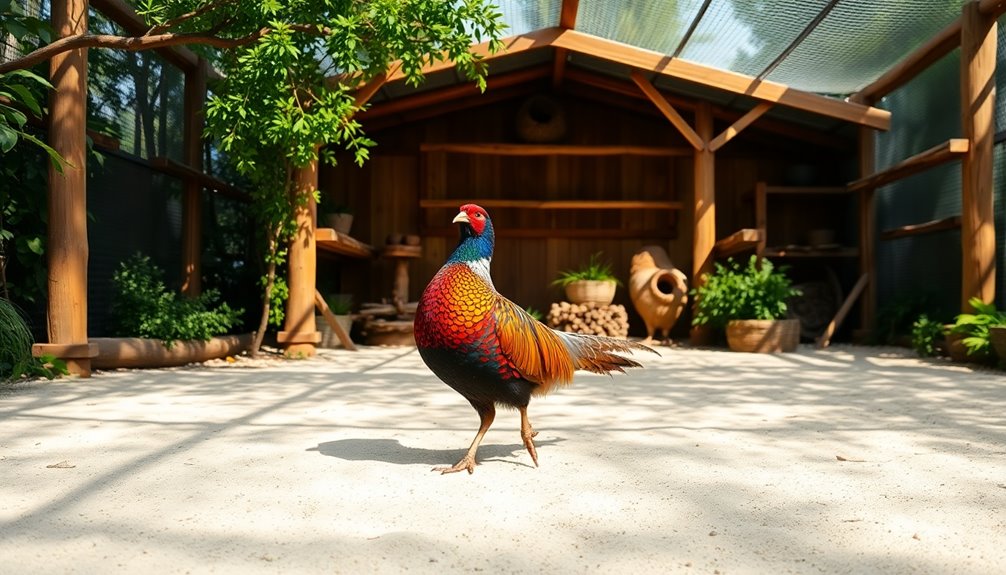
Creating a proper housing setup for your pet pheasant is essential for their health and happiness.
You'll need a secure aviary of at least 6 x 12 feet to allow them to engage in natural behaviors and prevent escape. Make certain to use natural flooring and provide shelter from wet conditions, guaranteeing a draft-free environment.
Incorporate landscaping with shrubs, grass, and perches to enhance their habitat. To safeguard against predators, add wire or metal skirts around the aviary and use sturdy fencing.
Additionally, include dry resting areas within the housing to promote comfort and health, allowing your pheasant to avoid damp conditions.
Proper housing guarantees your pet thrives and stays safe in your backyard or farm buildings.
Recommended Pheasant Species
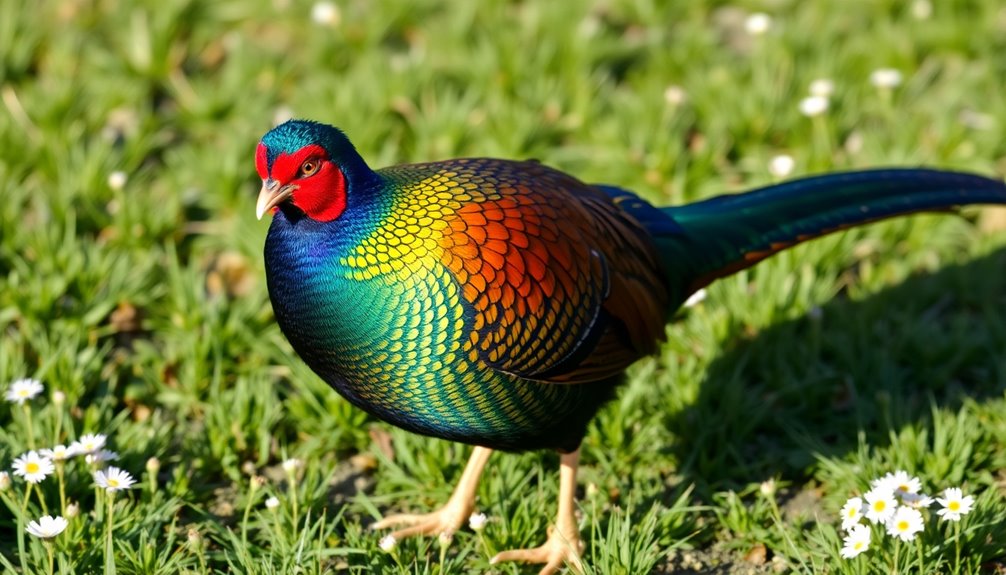
When choosing a pet pheasant, the species you select can greatly affect your experience.
Silver pheasants and red golden pheasants are known for their friendly natures, making them excellent companions.
In contrast, Chinese ringnecks can be skittish, which mightn't suit everyone looking for a sociable pet.
Friendliness of Species
If you're considering adding a pet pheasant to your home, the choice of species can greatly impact your experience.
Silver pheasants are a fantastic option due to their engaging personalities and less flighty behavior, making them more interactive.
Red golden pheasants are also friendly and tend to be quite approachable, often growing accustomed to human presence.
In contrast, Chinese ringnecks can be skittish and may require extra patience during the growing season for bonding.
Male silver pheasants usually display friendliness, while females can be more reserved.
Handling and Sociability
Handling and sociability are essential factors to weigh when choosing a pet pheasant.
If you're looking for a more interactive experience, consider silver pheasants. They're known for their engaging personalities and less flighty behavior, making them a great choice for bonding.
Red golden pheasants are also friendly and approachable, providing opportunities for positive human interaction.
On the other hand, Chinese ringnecks may not be ideal if you're seeking a social pet, as they tend to be skittish and harder to handle.
Pheasant Diet
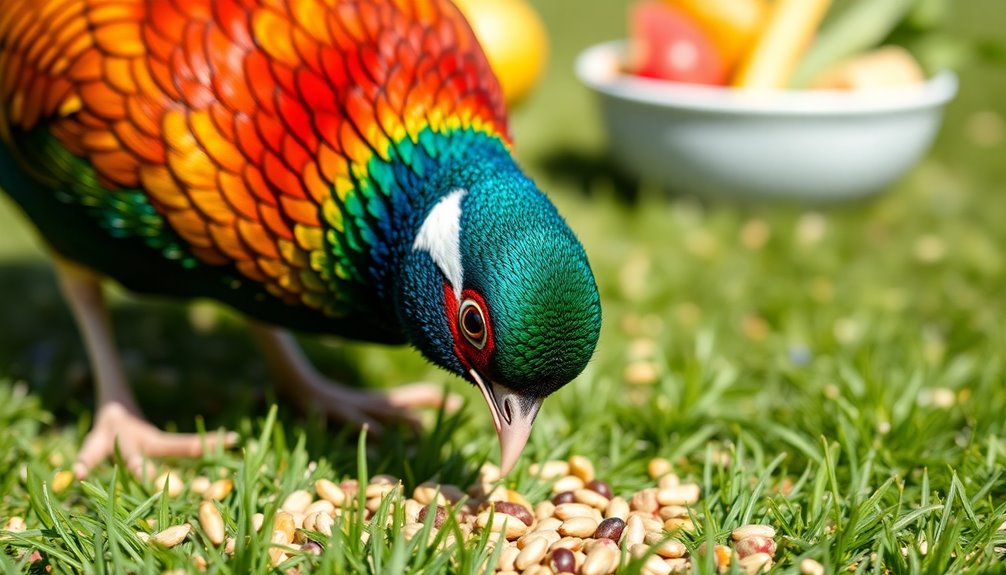
Providing a well-rounded diet is essential for your pheasant's health and energy. Start with high-quality game pellets, as they deliver the significant nutrients your bird needs for growth and vitality.
Occasionally, you can offer treats like mixed corn or grower pellets, but be careful—layers pellets can be too rich for male pheasants.
Remember, pheasants are insectivorous, so including bugs and mealworms in their diet provides a beneficial protein source.
Fresh greens and fruits are great supplements, but always halve grapes to avoid choking hazards.
Keep an eye on their feeding habits and preferences to guarantee they're getting adequate nutrition.
A balanced diet is critical for your pheasant's overall well-being and longevity.
Handling and Interaction
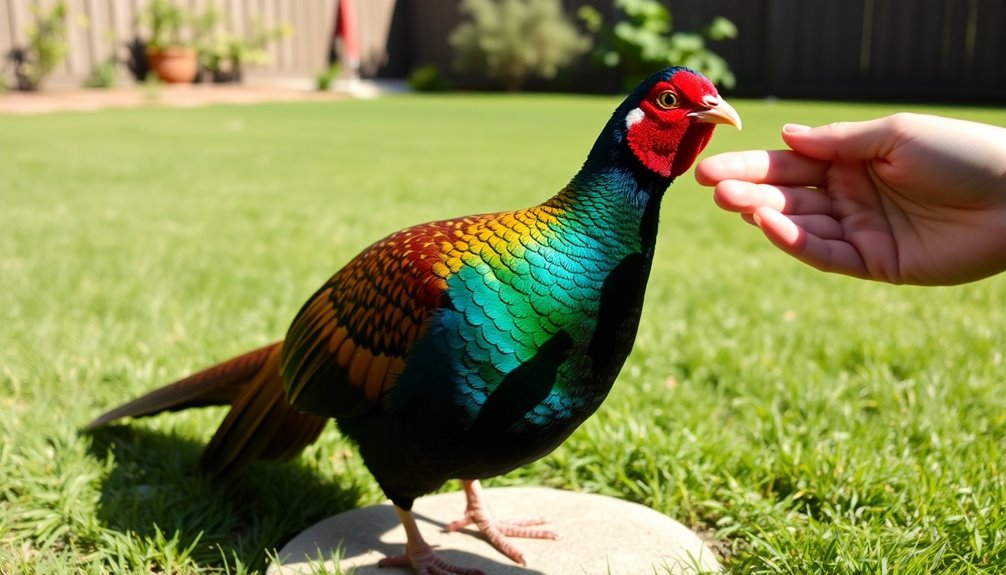
How can you foster a trusting relationship with your pet pheasant?
Start by understanding that pheasants typically dislike being picked up and may react defensively. Gentle handling is essential for safety.
Use positive reinforcement to build trust; offering treats like mealworms can encourage interaction over time.
Remember, most pheasants are shy and prefer to observe from a distance rather than engage directly.
To help them feel more comfortable, sit quietly and consistently offer food, allowing them to approach you at their own pace.
Patience is vital, as building a bond may take time due to their wild nature and limited trainability.
Celebrate small victories, and you'll gradually see your pheasant becoming more at ease with your presence.
Environment and Housing
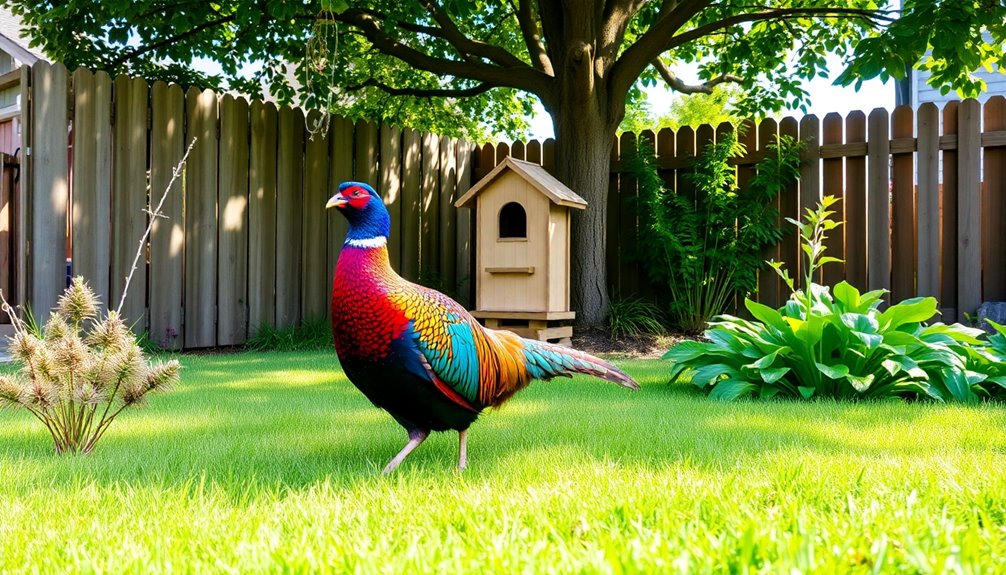
When setting up a home for your pet pheasant, you'll want to make sure the aviary is at least 6 x 12 feet to give them enough room to thrive.
Protecting their space from predators is vital, so consider using wire or metal skirts for security.
Aviary Size Requirements
Creating an ideal environment for your pet pheasant hinges on having an appropriately sized aviary. A minimum size of 6 x 12 feet is recommended to give your pheasant enough space to move around and engage in natural behaviors, which helps reduce stress.
Verify the flooring is natural, like grass or dirt, to promote comfort and encourage foraging. Your aviary also needs to provide shelter from inclement weather, so include a draft-free area where your pheasant can retreat.
Adding landscaping elements like shrubs, grass, and perches enhances their habitat, fostering their overall well-being. With the right design and size, your pheasant will thrive in a secure, stimulating environment.
Predator Protection Measures
Protecting your pet pheasant from predators is just as important as providing a spacious aviary.
Start by installing wire or metal skirts around the enclosure to prevent digging by ground predators like foxes and dogs. Make sure your aviary has a roof made of soft netting; this will deter aerial threats like raptors while preventing injury from falls.
High fencing, at least 5 feet tall and netted, is essential for securing free-range pheasants. Regularly inspect your housing to identify and fix any weak points that could be exploited.
Finally, consider implementing electric fencing around the perimeter of the aviary to greatly enhance security and deter potential intruders from approaching your feathered friend.
Benefits and Considerations

Although raising pet pheasants can be a rewarding experience, it's important to weigh both the benefits and considerations before diving in.
These visually stunning birds can enhance your garden's aesthetics, adding an exotic touch to your outdoor space. You'll also find their natural behaviors, like foraging and dust bathing, entertaining to observe. If you're a bird enthusiast, raising pheasants offers a unique hobby.
However, keep in mind that their wild nature and limited trainability mightn't fit your expectations for a traditional pet. They won't offer the companionship you might seek.
Additionally, understanding their specific housing and dietary needs is essential, as it guarantees they thrive in a secure and enriching environment.
Plan carefully to enjoy the full experience!
Breeding and Care
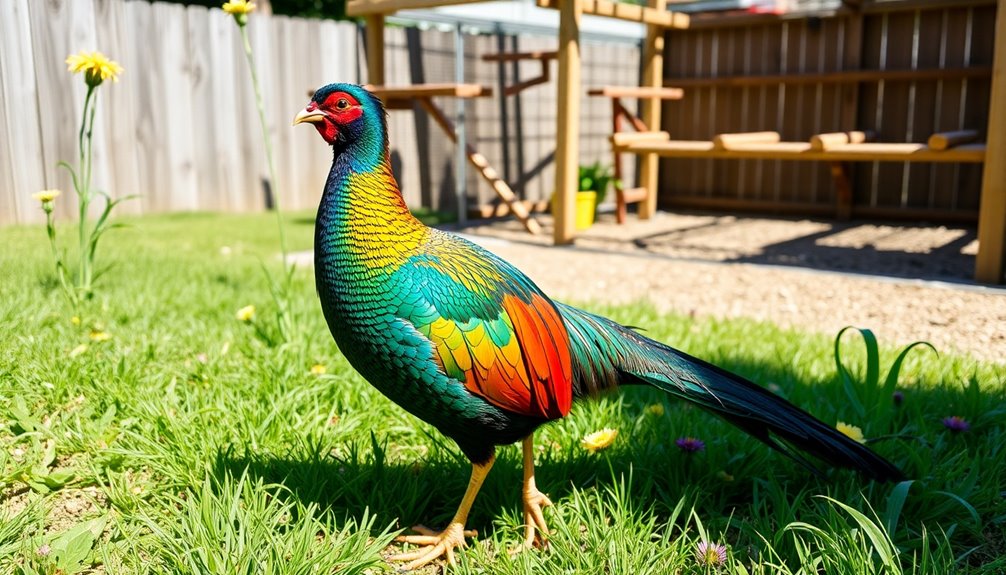
When it comes to breeding pheasants, understanding the right techniques is vital for success.
You'll need to provide proper care, including a spacious aviary and suitable nesting materials, to guarantee healthy breeding pairs.
Let's explore the essentials of breeding and care to help you get started on this rewarding journey.
Breeding Techniques Overview
To successfully breed pheasants, it's essential to understand their unique seasonal laying patterns, which dictate the times of the year when eggs are produced.
You'll need properly designed aviaries that provide ample space and environmental enrichment to support their natural behaviors.
Prioritize habitat management by ensuring there's sufficient nesting and brood-rearing cover to enhance the survival rates of hatchlings.
Regularly monitor your breeding pairs to assess compatibility and health, increasing your chances of successful reproduction.
Additionally, feed them a primary diet of game pellets, supplemented with greens and insects, to maintain their health and that of their chicks.
This combination of techniques will help you create a thriving breeding environment for your pheasants.
Care Requirements Essentials
Caring for pet pheasants requires attention to their specific needs to guarantee their health and happiness.
You'll need a spacious aviary, ideally 6 x 12 feet, with natural flooring to encourage their natural behaviors and minimize stress. Their primary diet should consist of game pellets, supplemented with greens, fruits, and occasional treats like mealworms for balanced nutrition.
Provide adequate shelter to protect them from predators and harsh weather, ensuring a draft-free space with dry resting areas. Regular cleaning of their habitat is essential to prevent disease and maintain their well-being.
Finally, establish trust through patience and consistent interaction, understanding that while they can acclimate to you, they'll still remain generally wild and less interactive than traditional pets.
Predator Management Strategies
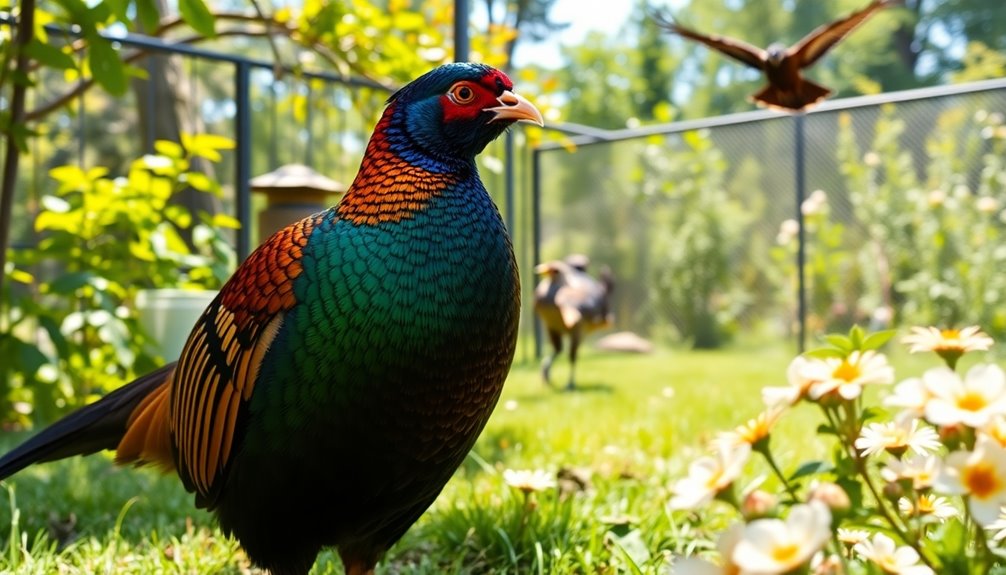
Protecting your pet pheasants from predators is essential for their well-being and safety. Pheasants are vulnerable to various threats like foxes, dogs, and birds of prey, so being aware of local wildlife is important.
To enhance security, consider implementing electric fencing around their enclosures. Additionally, bury wire mesh at least 18 inches deep to deter ground predators from digging in.
Regularly monitor and maintain traps for vermin like mice and rats, placing larger traps strategically for maximum effectiveness. Keeping the habitat clean and well-maintained is crucial to prevent disease spread among your birds.
Frequently Asked Questions
Will Pet Pheasants Fly Away?
Yes, pet pheasants can fly away if they're not properly contained.
To prevent this, you need secure housing, like an aviary that's at least 6 x 12 feet with high fencing. Clipping one wing can also help limit their flying ability.
When you first introduce a pheasant, be patient as they may seek cover instead of trying to fly.
Regularly monitor their environment and provide enrichment to keep them comfortable and secure.
How Do You Take Care of a Pet Pheasant?
Caring for a pet pheasant is like tending to a delicate garden; it requires attention and nurturing.
Create a spacious aviary, at least 6 x 12 feet, with natural flooring and shelters. Feed them game pellets, and add treats like mealworms and greens for a balanced diet.
Keep the environment calm, minimize human interaction, and maintain cleanliness. Watch for natural behaviors, ensuring they're happy and healthy in their enriching habitat.
How Hard Is It to Raise Pheasants?
Raising pheasants can be quite challenging. Their shy and flighty nature requires you to be patient and create a secure, enriching environment.
You'll need proper housing, ideally an aviary of at least 6 x 12 feet, to protect them from predators and harsh weather. Additionally, understanding their dietary needs is essential, as they thrive on game pellets and specific treats.
Early acclimatization is key, so younger birds are generally easier to manage than older ones.
Can I Raise Pheasants and Release Them?
Yes, you can raise pheasants and release them, but it requires careful planning.
Many believe simply raising them is enough, but it's not that straightforward. You'll need to acclimatize them to the wild, provide shelter and food during their changeover, and monitor local predators.
Clipping one wing helps control their movements initially. If you breed young pheasants, they'll likely adapt better to their new environment than older birds.
Conclusion
In conclusion, bringing a pet pheasant into your home can be a rewarding experience, but it requires careful planning and commitment. Did you know that the average lifespan of a domesticated pheasant can range from 5 to 10 years? That means you'll need to be prepared for a long-term relationship! By understanding their needs and behaviors, you can create a thriving environment for your feathered friend, ensuring both you and your pheasant enjoy a fulfilling companionship.

